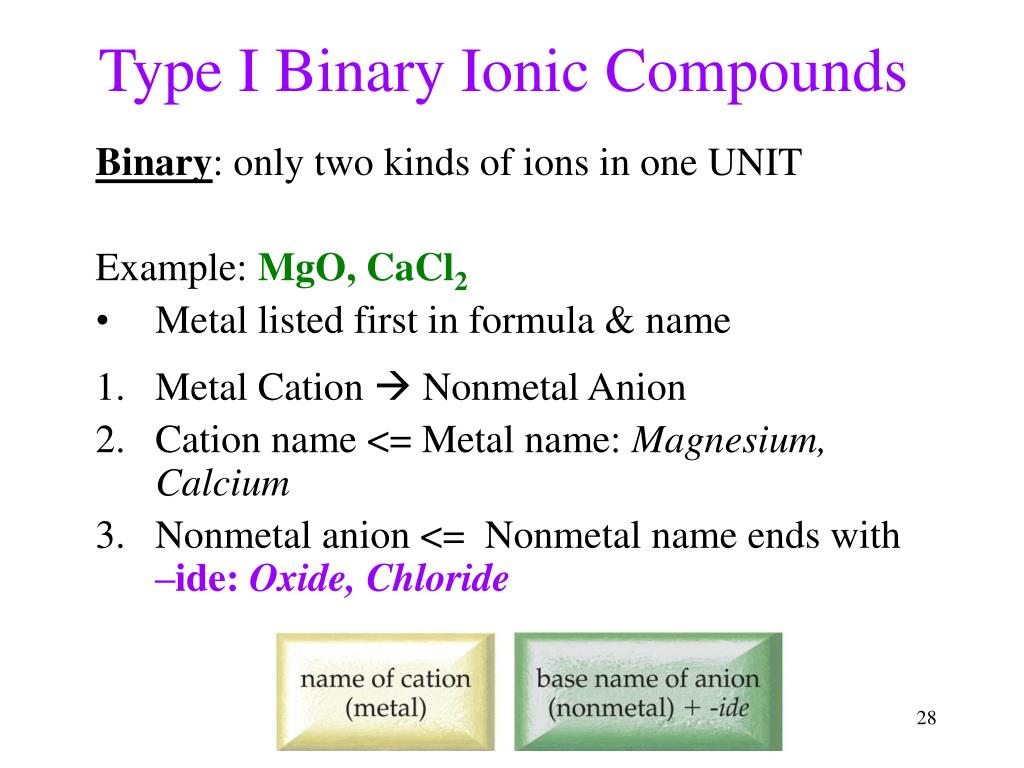Type Ii Binary Ionic Compounds. *please note that the transition metals zinc (zn), cadmium (cd), and silver (ag) do not have multiple charges. Binary ionic compounds (type ii) in the binary ionic compounds considered above (type i),the metal present forms only a single type of cation.

Fe 2+ and fe 3+ , pb 2+ and pb 4+. About binary of list compounds. Type ii metals are not type i metals.
Type Ii Metals Are Not Type I Metals.
Providing the name for the following type i binary ionic compounds: Fe 2+ and fe 3+ , pb 2+ and pb 4+. That is,sodium forms only na ,calcium forms only ca2,and so on.
Both The Metal And The Nonmetal Form Ions, Which Is Why It Is Called An Ionic Compound.
Type i binary ionic compounds contain a metal and a nonmetal and the metal that is present only forms one type of cation. Kdl's ionic compound nomenclature practice. Naming type i binary ionic compounds (metal and nonmetal):
The Cation Is Written First In The Name;
Type ii binary ionic compounds also contain a metal and a nonmetal however the metal that is present here can form more than one type of cation. • fe 2o3 • sns • nibr2 •cus • pb 3p2 • cubr • fecl3 They can be separated into three major classes.
Chemical In Which Cation Is Hydrogen Elemental Ions Oxyanions Determining Type I, Ii Or Iii Chem Formula:
In this video we will learn about type ii binary ionic compounds and learn how to name and write the chemical formulas for them. Type ii binary ionic compounds type ii binary ionic compounds contain a metal that can form more than one type of cation. Day 3 week 3 naming type ii binary ionic compounds practice draft.
Both The Metal And The Nonmetal Form Ions , Which Is Why It Is Called An Ionic Compound.
The name of the cation is the same as the (neutral) element from which it is derived. While naming type i binary ionic compounds is pretty straightforward, we also have to make sure the formulas are correct based on balancing their ion charges so that the overall compound has no net charge (i.e. Metals with only one cation (shaded below with charges).
Related Posts
- Difference Between Ionic Compound And Molecular CompoundDifference Between Ionic Compound And Molecular Compound. The main difference between both compounds is that ionic compounds are formed by the transf ...
- Which Type Of Bow Has Limbs That Curve Away From The Belly Of The BowWhich Type Of Bow Has Limbs That Curve Away From The Belly Of The Bow. Several types have limbs that curve away from the belly of the bow. A reflex b ...
- Are Ionic Or Covalent Bonds StrongerAre Ionic Or Covalent Bonds Stronger. But, when molecules with ionic bonds are dissolved in water the ionic bonds become much weaker in comparison to ...
- Which Type Of Boat Must Have A Capacity PlateWhich Type Of Boat Must Have A Capacity Plate. Start studying pa boat chapter 1 study. Does a boat need a capacity plate?Maximum Capacities plate dec ...
- Properties Of Rna Sort Each Description By The Type Of Rna It DescribesProperties Of Rna Sort Each Description By The Type Of Rna It Describes. Drag each item to the appropriate bin. Ribosomal rna (rrna) messenger rna (m ...
- Predict Whether Each Of The Following Ionic Compounds Is Soluble In WaterPredict Whether Each Of The Following Ionic Compounds Is Soluble In Water. Generally, we can apply the like dissolves like rule to determine if a com ...
- Which Payment Type Can Help You Stick To A BudgetWhich Payment Type Can Help You Stick To A Budget. Debit cards which of the following is not true of credit cards? Ways of staying within budget.The ...


